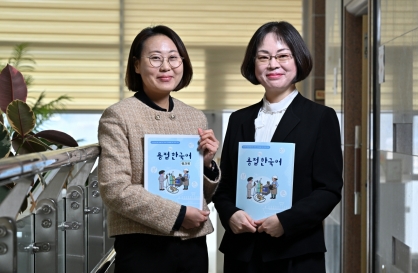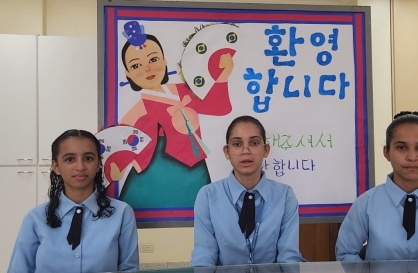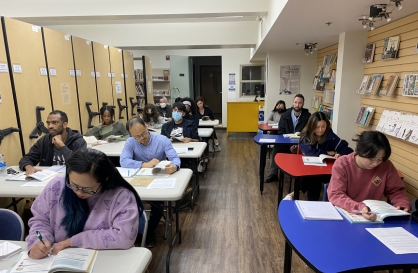Most Popular
Hello Hangeul
-
1
Welding book first in vocational Korean series for foreign labor

-
2
[Korea Beyond Korea] In Sao Paulo, horizons expand for Korean studies
![[Korea Beyond Korea] In Sao Paulo, horizons expand for Korean studies](//res.heraldm.com/phpwas/restmb_idxmake.php?idx=644&simg=/content/image/2023/11/20/20231120000619_0.jpg&u=20231206104853)
-
3
In Brasilia, worldly dreams are born from Korean classes

-
4
Americans seeking to visit Korea learn the language in LA

-
5
[Korea Beyond Korea] Berlin, Europe's Korean Studies hub, nurtures next-gen experts, scholars
![[Korea Beyond Korea] Berlin, Europe's Korean Studies hub, nurtures next-gen experts, scholars](//res.heraldm.com/phpwas/restmb_idxmake.php?idx=644&simg=/content/image/2023/10/18/20231018000929_0.jpg&u=20231023154735)
[Hello Hangeul] Writing or art? Hangeul inspires artists
By Park YunaPublished : July 30, 2023 - 17:31

The following series is part of The Korea Herald’s “Hello Hangeul” project which consists of interviews, in-depth analyses, videos and various other forms of content that shed light on the stories of people who are learning the Korean language and the correlation between Korea’s soft power and the rise of its language within the league of world languages. – Ed.
Letters and paintings used to go hand in hand historically -- Korean literati in the Joseon era (1392-1910) would paint with Chinese letters, in a style accompanied by a poem or writing to express their thoughts.
Scholar Chusa Kim Jeonng-hui (1786-1856) in the late Josen era is famously known for the masterpiece "Sehando," created in the most difficult time of his life, after he was sent in exile to Jeju Island in 1840.
Next to the painting of old and lonely pine trees is writing that reflects his thoughts as a seonbi, or scholar respected for his virtuousness and intelligence. The painting was designated as a national treasure.

About a century later, Kim Whan-ki, a pioneer of Korean abstract art, painted “Jar and Poetry." Created in 1954, the work deceits a moon jar and apricot flowers complemented by a poem by the artist's friend, Korean poet Seo Jeong-ju.
While the composition of a mixture of painting and text was the same as that traditionally used in the Joseon era, the words were written in Hangeul.
Kim's artwork represents endeavors by Korean artists who have taken inspiration from the Korean alphabet, comprised of 24 basic letters, since Korea's liberation from Japan in 1945.

Korean modern art master Lee Ung-no, who is famously known for his abstract letter series and Gunsang (people) paintings, was one of the artists who agonized over the integration of Korea’s traditional painting elements and Western art during his artistic journey. Born in 1904, the artist emigrated to France in 1958.
“Lee started to create an abstract letter series after settling in France in 1958. That was part of his efforts to create art that held elements from Western and Korean art. Lee never clarified which letters he used for the abstract letter series, but it is believed that Hangeul had become part of Lee’s inspiration,” said Kim Eun-jung, curator at the Lee Ungno Museum in Daejeon.
Lee delved into his abstract letter series from the 1960s to 1970s, produced based on calligraphy techniques employed in Korean paintings. Most of his calligraphic abstract letter works are composed vertically, as if he took inspiration from the scroll form of traditional calligraphy.

Another Korean-born art master, Paik Nam-june is widely known for pioneering video art, but it is less well-known that he used to enjoy using different languages in his art.
Born in 1932, he grew up speaking Korean at home and learning Japanese in school during the Japanese colonial era. After moving to Germany and the US, he had five linguistic systems -- Korean, Japanese, English, German and French.
“Though known as a media artist, Paik was also a ‘language artist.’ …. On the TV cabinets and surfaces, Paik often painted Korean words or Chinese characters that related to the title of the work,” American linguist Robert J. Fouser wrote in the catalog “The Future of Silence: When your tongue vanishes,” published by the Nam June Paik Art Center.
An untitled painting by Paik, owned by the Nam June Paik Art Center and created with oil sticks in 2001, shows 14 Korean consonants in the middle with idioms and names of Korean poets such as Jeong Ji-yong and Kim So-wol written around them.
In another work also from 2001, Paik painted the Sahasrabhuja Lokeshvara, a Buddhist saint believed to have 1,000 hands and 11 faces, over a background of television color bars. He wrote Korean letters pronounced “ga na da ra” and “Bucheo,” meaning "Buddha" in Korean. The painting was created after the artist after a stroke affected the artist in 1996.

Kang Ik-joong, meanwhile, is known for paintings and installations featuring two major motifs: moon jars and small Hangeul letter blocks.
One of his recent works is a cube installation titled “Gwanghwamun Arirang,” unveiled in 2020 at the heart of Seoul in Gwanghwamun, measuring 8 meters in length, width and height. The installation shows moon jars filled with drawings by children from South Korea and the 22 nations that participated in its support in the 1950-53 Korean War. The moon jars are surrounded by Hangeul letter blocks that spell out the lyrics to Korean folk song Arirang.
The installation delivers the hope of the artist and many people who wish for the unification of the two Koreas. The installation was created to mark the 70th anniversary of the Korean War. The installation rotated 90 degrees every 70 seconds, dividing the moon jars and then making them whole again.

Another contemporary artist, Kim Ji-pyeong has recently fallen for Hangeul, particularly the consonant "rieul," shaped like a backward "s" and pronounced similarly to the "r" or "l" sound in English. Kim found there are many single words in Korean that have a "rieul" -- such as "byul" for star, "gil" for a road or "bul" for fire. Kim would paint the image or the word or make prints with the consonant "rieul."
After exploring traditional Korean painting at Ewha Womans University, Kim has created works that embody her own interpretation of traditional Korean painting elements in a contemporary way. Her “Rieul" series began in 2017.

“Before the modern time, painting in East Asia had been developed without separating the concept of writing and painting. The materials used to write and paint were even the same," Kim said. “When I create art using ‘rieul,’ I recognize the unique shape of the consonant and come to think of the original meaning of the words that can be ‘completely’ translated in different languages."







![[Today’s K-pop] Blackpink’s Jennie, Lisa invited to Coachella as solo acts](http://res.heraldm.com/phpwas/restmb_idxmake.php?idx=644&simg=/content/image/2024/11/21/20241121050099_0.jpg&u=20241121172748)




![[Korea Beyond Korea] In Sao Paulo, horizons expand for Korean studies](http://res.heraldm.com/phpwas/restmb_idxmake.php?idx=644&simg=/content/image/2023/11/20/20231120000619_0.jpg&u=20231206104853)


![[Korea Beyond Korea] Berlin, Europe's Korean Studies hub, nurtures next-gen experts, scholars](http://res.heraldm.com/phpwas/restmb_idxmake.php?idx=644&simg=/content/image/2023/10/18/20231018000929_0.jpg&u=20231023154735)







![[Today’s K-pop] Babymonster logs 100m views with ‘Drip’ music video](http://res.heraldm.com/phpwas/restmb_idxmake.php?idx=642&simg=/content/image/2024/11/22/20241122050051_0.jpg&u=20241122172213)